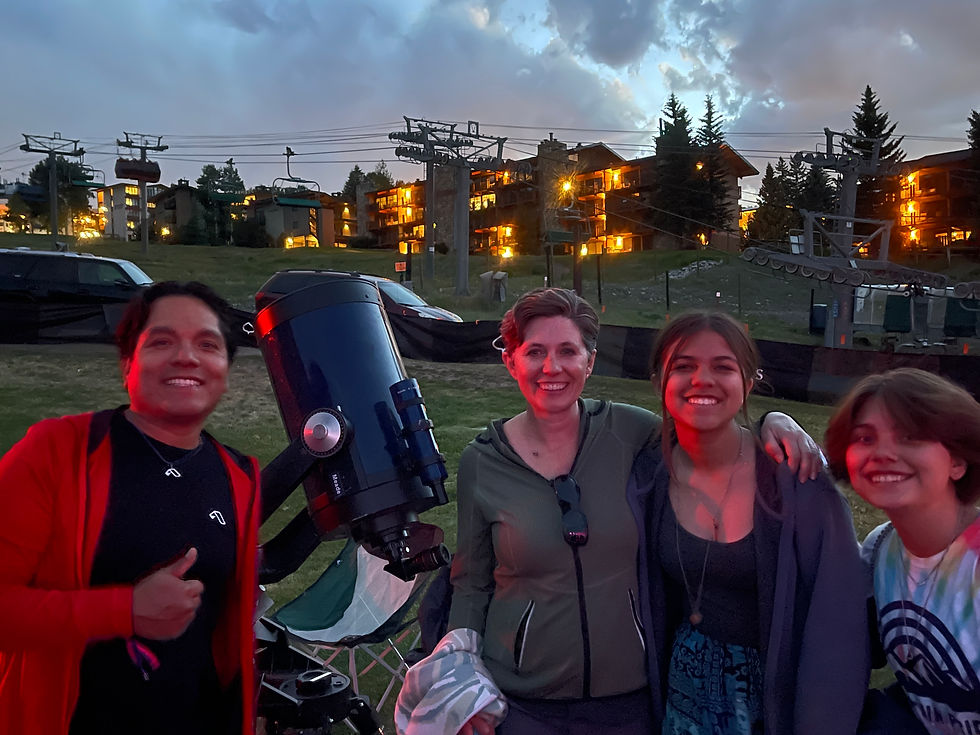Seeing the Same Sky: From the Perseids to the Moon, No Matter Where You Are
- Luke

- Aug 13
- 4 min read
The Perseids meteor shower is one of the best sky shows of the year, and it’s peaking again this August. If you’re anywhere with a dark sky, it’s worth making time for. But this year, as I watch it from here in Australia, I found myself thinking about a question that first came to me more than 13 years ago.

Back then, I was living in California and dating someone in Colorado. One night during the Perseids, we were both outside, talking on the phone, trying to see if we could spot the same meteor. Every time one of us gasped, the other would check if they’d just seen it too. The relationship didn’t last, but the question stuck in my head. Could we actually have been seeing the same shooting stars?
How far can two people be and still see the same meteor?
Most meteors burn up at an altitude of about 80–120 km. If the meteor is right on your horizon, the furthest someone else can be and still see it is about 2,000–2,500 km away.
The geometry is pretty simple. Imagine Earth as a circle of radius R (~6,371 km) and the meteor at height h. Draw a line from the meteor to an observer so that it just grazes the Earth (a tangent). That makes a right triangle with:
OA = R (Earth’s radius)
OM = R + h (Earth + meteor height)
Using the cosine rule for that right triangle:
\cos\theta = \frac{R}{R + h}
Here, \theta is the angle from the meteor’s “sub-point” to your horizon. Two people on opposite sides of that sub-point can each be \theta away, so the max surface separation is:
s_{\text{max}} = 2 R \theta = 2 R \arccos\left(\frac{R}{R + h}\right)
Plug in:
h = 100 km → ~2,270 km
h = 120 km → ~2,485 km
So in California and Colorado, we were close enough — but here in Australia, I’m over 14,000 km from Colorado, so there’s no way to share a meteor in real time.
What about satellites like the ISS?
The same formula works — you just change h. The ISS orbits at about 420 km, which means the maximum shared view jumps to ~4,500 km. That covers much of a continent, but still not enough for me here in Broome, WA to wave at someone in Boulder, CO and watch the ISS together.
And the Moon?
Now we’re talking big numbers. The Moon is ~384,400 km away, so its parallax (the shift you see from different points on Earth) is just under 1°. That means two people can be almost half an Earth apart — about 20,000 km — and still see the Moon at the same time.
In fact, Broome and Boulder are about 14,863 km apart, so I can absolutely FaceTime my family in Colorado and have us point at the same Moon. I’ve done it.
Pushing the absolute limit
If you put observers exactly at the North and South Poles, they’re 20,037 km apart. Without atmosphere, they could just barely both see the Moon at the same time if it’s exactly on the horizon for both. But Earth’s atmosphere bends light upward by about 0.5°, and the Moon’s parallax gives another ~0.95° to each observer. Together, that’s about 3° of extra “reach”, which stretches the maximum to ~20,300 km. That means the poles can indeed share the Moon — or even the Sun at equinox — for a short while.
How to watch the Perseids this year
The Perseids peak on the night of August 13th. Normally, the best viewing is after midnight, when your part of Earth is facing into the stream of comet dust — like looking out the front windshield instead of the side window as we plow through space.
But this year, the Moon rises around 10 PM, so the sweet spot will be 9 PM–11 PM on the 13th before moonlight washes out the fainter meteors. Find a dark spot, lie back, and take in as much of the sky as possible — meteors appear all over, not just in the “radiant” in Perseus.
Bring:
A blanket or reclining chair
Warm clothes
Patience — your eyes need ~20 minutes to adjust to darkness
Other sights while you’re out
Early evening:
Arcturus, Vega, Antares, Mars, and the Summer Triangle
The Hercules Cluster (M13) and the Butterfly Cluster (M6)
Double stars like Mizar and Alberio
Later in the night:
The Moon rising
Saturn nearby (always a crowd-pleaser through a telescope)
Bright constellations and the Milky Way
Let the sky connect you
That night in California all those years ago, I might well have been watching the same meteor my partner in Colorado saw. From here in Australia, I know I can’t share a Perseid with my family back home — but we can still share the ISS, or the Moon, or the Sun at the same time.
Let the meteor shower connect you to those around you. Let satellites connect you to friends a continent away. Let the Moon connect you to loved ones on the far side of the world. And let the stars connect you to the universe and beyond — and let AstroTours help you make that connection.

.png)


Comments